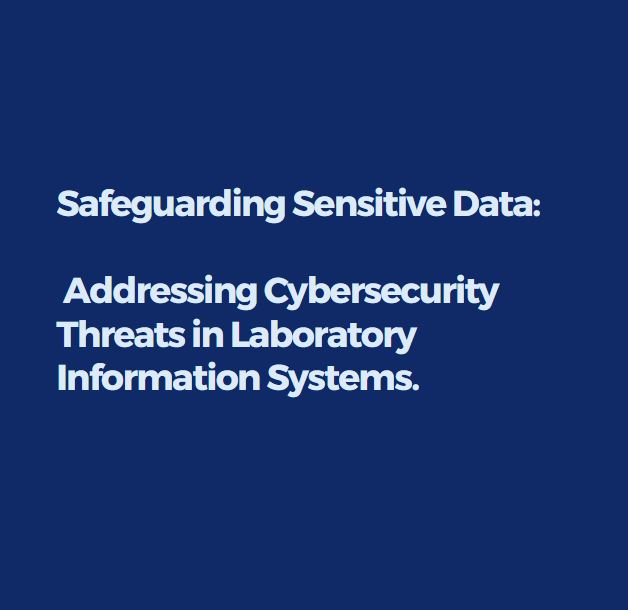In today’s digital age, where information is a valuable asset, protecting sensitive data has become paramount. This holds especially true in the healthcare sector, where patient confidentiality and data integrity are of utmost importance. Laboratory Information Systems (LIS) play a critical role in managing and organizing vast amounts of medical data generated in laboratories. However, with the convenience of digitization comes the risk of cybersecurity threats.
Cybersecurity threats targeting LIS software are on the rise, posing significant risks to patient privacy, data security, and overall healthcare operations. From ransomware attacks to data breaches, the consequences of a security breach in LIS can be devastating. Therefore, it is imperative for healthcare organizations to implement robust security measures to safeguard their LIS software and protect sensitive information.
Understanding the Threat Landscape
Before delving into cybersecurity measures, it’s essential to grasp the various threats that can compromise the security of laboratory information systems:
- Malware Attacks: Malicious software such as viruses, worms, and ransomware can infiltrate LIS software systems, causing data corruption, theft, or system disruption.
- Insider Threats: Employees or individuals with authorized access to the LIS software may intentionally or unintentionally compromise data security through actions like unauthorized access, data theft, or negligence.
- Phishing Attacks: Cybercriminals often use phishing emails or fake websites to trick users into disclosing sensitive information such as login credentials, which can then be used to gain unauthorized access to LIS software.
- Vulnerabilities in Software: Unpatched software vulnerabilities can be exploited by cyber attackers to gain access to LIS systems and compromise data integrity.
Addressing Cybersecurity Threats
To mitigate the risks associated with cybersecurity threats in laboratory information systems, healthcare organizations should adopt a proactive approach towards security. Here are some key measures that can help in addressing these threats effectively:
Implement Robust Access Controls:
Limit access to LIS software based on the principle of least privilege, ensuring that users only have access to the data and functionalities necessary for their roles. Implement multi-factor authentication (MFA) to enhance login security and prevent unauthorized access.
Regular Security Audits and Risk Assessments:
Conduct regular security audits and risk assessments to identify vulnerabilities and weaknesses in the LIS software. Address any identified vulnerabilities promptly and implement security patches and updates in a timely manner.
Employee Training and Awareness:
Educate employees about cybersecurity best practices, including how to recognize and report phishing attempts, the importance of strong passwords, and the risks associated with sharing sensitive information. Foster a culture of cybersecurity awareness within the organization.
Data Encryption:
Implement robust encryption mechanisms to protect data both at rest and in transit within the LIS software. Encryption ensures that even if data is intercepted or stolen, it remains unreadable and unusable to unauthorized parties.
Secure Network Infrastructure:
Implement firewalls, intrusion detection systems, and other network security measures to protect the network infrastructure supporting the LIS software. Monitor network traffic for suspicious activities and take appropriate action to mitigate potential threats.
Incident Response Plan:
Develop and regularly update an incident response plan outlining procedures to be followed in the event of a cybersecurity incident involving the LIS software. Define roles and responsibilities, establish communication channels, and conduct regular drills to test the effectiveness of the plan.
Regular Software Updates and Patch Management:
Stay vigilant about software updates and patches released by the LIS software vendors. Promptly apply security patches to address known vulnerabilities and minimize the risk of exploitation by cyber attackers.
Regular Security Updates and Patch Management:
Stay proactive in keeping your LIS software up-to-date with the latest security patches and updates. Regularly check for updates from the software vendor and ensure they are applied promptly to address any newly discovered vulnerabilities. Patch management is a critical component of cybersecurity hygiene and helps prevent exploitation of known security flaws by cyber attackers.
Data Backup and Recovery:
Implement robust data backup and recovery procedures to ensure that critical laboratory data stored within the LIS software is protected against loss or corruption. Regularly back up data to secure off-site locations and test the integrity of backups to verify their reliability. In the event of a cybersecurity incident or data breach, having a reliable backup ensures that you can restore essential data and resume operations quickly.
Continuous Monitoring and Threat Detection:
Utilize advanced monitoring tools and threat detection technologies to continuously monitor the activity within your LIS software environment. Implement real-time alerts and notifications for suspicious activities or anomalies that may indicate a potential security threat. By proactively monitoring and detecting security incidents, you can quickly respond and mitigate the impact of cyber attacks on your laboratory information systems.
Vendor Security Assessments:
Conduct thorough security assessments of LIS software vendors before procuring or implementing their solutions. Evaluate the vendor’s security practices, data protection measures, and compliance with industry standards and regulations. Ensure that the vendor follows best practices for secure software development and maintenance and has a robust security posture to protect against potential threats.
Collaboration and Information Sharing:
Engage in collaborative efforts with other healthcare organizations, industry partners, and cybersecurity experts to share information and best practices for addressing cybersecurity threats in laboratory information systems. Participate in industry forums, conferences, and working groups focused on healthcare cybersecurity to stay updated on the latest trends, threats, and mitigation strategies. By sharing knowledge and experiences, organizations can collectively strengthen their defenses against cyber attacks.
Conclusion
In conclusion, addressing cybersecurity threats in laboratory information systems is essential for safeguarding patient data, maintaining data integrity, and ensuring the smooth functioning of healthcare operations. By implementing robust security measures such as access controls, regular audits, employee training, encryption, and incident response planning, healthcare organizations can significantly reduce the risk of cybersecurity breaches and protect their LIS software from malicious actors. Ultimately, a proactive approach to cybersecurity is crucial in maintaining trust and confidence in the healthcare system and safeguarding the privacy and security of sensitive medical information.
By implementing robust security measures such as access controls, encryption, data backup, and threat detection, healthcare organizations can mitigate the risks posed by cyber attacks and protect sensitive medical data stored within LIS software. A proactive stance towards cybersecurity, coupled with ongoing monitoring and continuous improvement, is essential for ensuring the integrity, confidentiality, and availability of laboratory information systems in today’s increasingly digital healthcare landscape.
Also read – https://blogozilla.com/building-knowledge-graphs/
Also check the mangohr application for your hr needs



